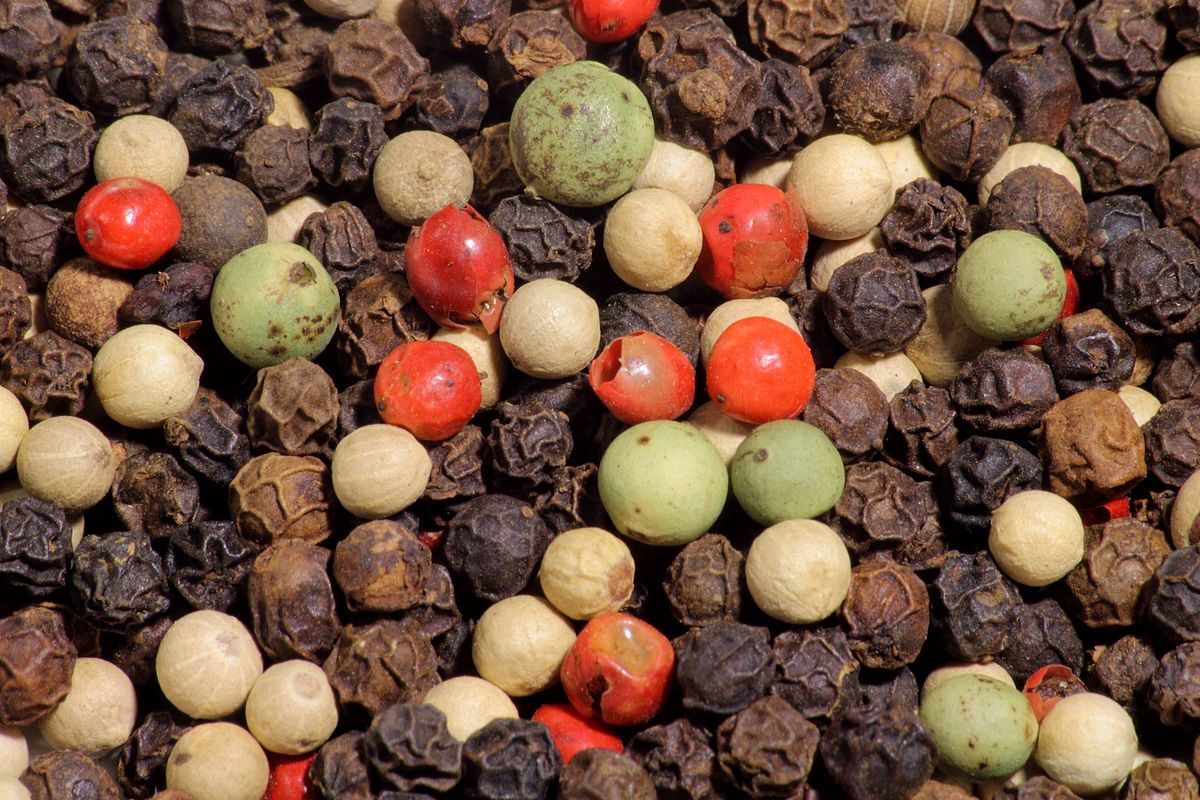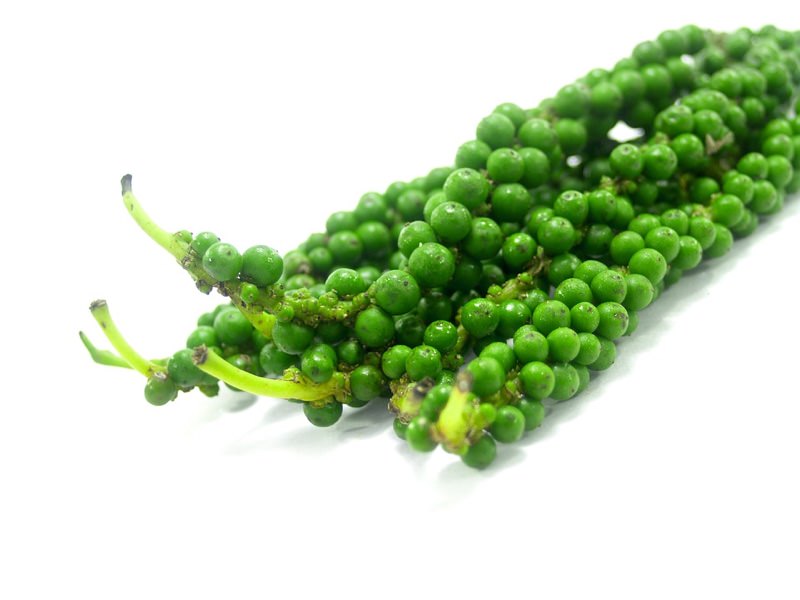The Modern Farmer Guide to Peppercorns
Black, white, green, pink, long, Szechuan, and more!
The Modern Farmer Guide to Peppercorns
Black, white, green, pink, long, Szechuan, and more!

First, a little background
Peppercorn, in its various forms, is the world’s most traded spice. It was once even used in its native South and Southeast Asia as currency. It is not in any way related to the New World’s many varieties of chili pepper, though it does have a sort of spiciness that comes from a totally different compound than what you’d find in a chili.
While there are a whole bunch of different products referred to as pepper or peppercorns, only a few of them are technically peppercorns. True peppercorns come from the Piper nigrum plant, a lush, tropical-looking vine that produces long strands of small fruits. Each fruit – technically a drupe, sort of like the individual segments of a raspberry or blackberry – contains one seed. Peppercorn was not, as a common myth goes, used either as a preservative or to disguise the flavor of spoiled meat in antiquity; it’s not a very good preservative, and it was too expensive to waste on spoiled meat. (Besides, people knew even then that eating spoiled meat was dangerous.) Instead it’s likely always simply been a prized flavoring, loved for its bite and punch.
Now let’s get into the different types!
Black Peppercorn
The most common preparation of pepper, black peppercorn is created by taking all those tiny fruits while still unripe and green and quickly cooking them, often by boiling. The heat releases enzymes that discolor the fruit, turning it a kind of deep brown color which is deepened further through the next process, drying. Drying can be done either mechanically or by the sun, and basically disintegrates the pulp of the fruit, wrinkling and cementing the skin to the seed within.
This preparation is by far the most popular way to treat the fruit, showing up in cuisines from China to Vietnam to Western Europe.
Tellicherry Black Peppercorn
You might see this one at fancy spice markets or name-checked at restaurants. The Tellicherry black peppercorn doesn’t refer to quality or place of origin, but instead to size: Tellicherry peppercorns are larger than regular black peppercorns, and the size difference affects flavor – Tellicherry peppercorns are renowned for being less spicy but more complex, with distinct citrus notes.
White Peppercorn
White peppercorn is created by removing the skin and the pulp from the fruit and using only the seed. Usually, this is done by submerging the fruit in water for a few days, after which it swells and separates from the seed. White peppercorn is spicier but less fruity than black, and it’s commonly used in Chinese cuisine (or if you’re cooking something white, like mashed potatoes, and don’t want to see flecks of black in there).

Green Peppercorn
The last of the true peppercorns, green peppercorns can show up in one of two forms. One is treated basically like black peppercorns, but with a chemical added to preserve their natural green color, like sulfur dioxide. (This is the same chemical that keeps golden raisins golden.) When dried, they sometimes have a milder flavor than black, but not necessarily.
The second type of green peppercorn is more rare and more expensive, either sold completely fresh right off the vine (unusual, because the fruit decomposes quickly) or preserved in a brine. If preserved, they still have that bright spiciness, but are also acidic thanks to the preserving process, and are most commonly seen in Thai cuisine.

Long Pepper
Not exactly a peppercorn, but closely related to Piper nigrum, the long pepper comes from these oblong spikes on the end of the plant that are covered by tiny fruits. It looks sort of like the tip of a strand of wheat. Native to Indonesia, long pepper is sort of a pain to grow, at least compared with peppercorns, but has an even spicier, more complex flavor. Typically you’ll find the entire spike dried, though they’re pretty expensive.
Pink Peppercorn
Lies! The pink peppercorn is not a peppercorn at all. It comes from a South American evergreen tree in the cashew family, which produces small pink fruits. These fruits are dried, but unlike black peppercorns, they’re not usually cooked first and therefore retain their nice, pink color. They have a slightly fruity flavor, not as intense a heat as true peppercorns, and are physically much more delicate. Owing to its membership in the cashew family, people with nut allergies should avoid the pink peppercorn.

Szechuan Peppercorn
Another liar. Totally unrelated to the peppercorn, this Chinese spice is made from the seedpods of a plant distantly related to citrus. It also tastes nothing like other peppercorns; it’s not at all spicy or peppery, instead creating this bizarre, numb feeling in the mouth. It’s an essential part of classic Szechuan dishes like mapo tofu.

Unusual Pepper Substitutes
The distinctive peppery flavor of peppercorns is not exclusive to the Piper nigrum plant, as the pink peppercorn and long pepper show. You can find it in all kinds of weird places! For example: papaya seeds, the little round black fellows you probably throw out when you cut into a papaya, are edible and have a surprisingly similar flavor to black pepper. (To use, just wash and smash in a mortar and pestle, or wash and allow to air-dry before grinding.)
Several species of the best genus of vegetables, Brassica (which includes broccoli, cabbage, cauliflower, kale, and mustard), have seeds with a pepper-like flavor. Field pepperweed is an invasive plant throughout much of North America, and its seeds are described as having a peppery, mustardy sort of zing. Same with the native Virginia pepperweed, which you’ve probably seen before and not recognized as a noble member of the brassica family.
Follow us

This work is licensed under a Creative Commons Attribution-NoDerivatives 4.0 International License.
Want to republish a Modern Farmer story?
We are happy for Modern Farmer stories to be shared, and encourage you to republish our articles for your audience. When doing so, we ask that you follow these guidelines:
Please credit us and our writers
For the author byline, please use “Author Name, Modern Farmer.” At the top of our stories, if on the web, please include this text and link: “This story was originally published by Modern Farmer.”
Please make sure to include a link back to either our home page or the article URL.
At the bottom of the story, please include the following text:
“Modern Farmer is a nonprofit initiative dedicated to raising awareness and catalyzing action at the intersection of food, agriculture, and society. Read more at <link>Modern Farmer</link>.”
Use our widget
We’d like to be able to track our stories, so we ask that if you republish our content, you do so using our widget (located on the left hand side of the article). The HTML code has a built-in tracker that tells us the data and domain where the story was published, as well as view counts.
Check the image requirements
It’s your responsibility to confirm you're licensed to republish images in our articles. Some images, such as those from commercial providers, don't allow their images to be republished without permission or payment. Copyright terms are generally listed in the image caption and attribution. You are welcome to omit our images or substitute with your own. Charts and interactive graphics follow the same rules.
Don’t change too much. Or, ask us first.
Articles must be republished in their entirety. It’s okay to change references to time (“today” to “yesterday”) or location (“Iowa City, IA” to “here”). But please keep everything else the same.
If you feel strongly that a more material edit needs to be made, get in touch with us at [email protected]. We’re happy to discuss it with the original author, but we must have prior approval for changes before publication.
Special cases
Extracts. You may run the first few lines or paragraphs of the article and then say: “Read the full article at Modern Farmer” with a link back to the original article.
Quotes. You may quote authors provided you include a link back to the article URL.
Translations. These require writer approval. To inquire about translation of a Modern Farmer article, contact us at [email protected]
Signed consent / copyright release forms. These are not required, provided you are following these guidelines.
Print. Articles can be republished in print under these same rules, with the exception that you do not need to include the links.
Tag us
When sharing the story on social media, please tag us using the following: - Twitter (@ModFarm) - Facebook (@ModernFarmerMedia) - Instagram (@modfarm)
Use our content respectfully
Modern Farmer is a nonprofit and as such we share our content for free and in good faith in order to reach new audiences. Respectfully,
No selling ads against our stories. It’s okay to put our stories on pages with ads.
Don’t republish our material wholesale, or automatically; you need to select stories to be republished individually.
You have no rights to sell, license, syndicate, or otherwise represent yourself as the authorized owner of our material to any third parties. This means that you cannot actively publish or submit our work for syndication to third party platforms or apps like Apple News or Google News. We understand that publishers cannot fully control when certain third parties automatically summarize or crawl content from publishers’ own sites.
Keep in touch
We want to hear from you if you love Modern Farmer content, have a collaboration idea, or anything else to share. As a nonprofit outlet, we work in service of our community and are always open to comments, feedback, and ideas. Contact us at [email protected].by Dan Nosowitz, Modern Farmer
April 27, 2017
Modern Farmer Weekly
Solutions Hub
Innovations, ideas and inspiration. Actionable solutions for a resilient food system.
ExploreExplore other topics
Share With Us
We want to hear from Modern Farmer readers who have thoughtful commentary, actionable solutions, or helpful ideas to share.
SubmitNecessary cookies are absolutely essential for the website to function properly. This category only includes cookies that ensures basic functionalities and security features of the website. These cookies do not store any personal information.
Any cookies that may not be particularly necessary for the website to function and are used specifically to collect user personal data via analytics, ads, other embedded contents are termed as non-necessary cookies.